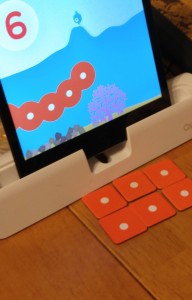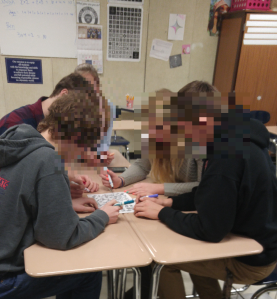
Since it was Christmas, and we finally had some free time, I decided to bust out something she had gotten earlier this month: Osmo Numbers. I have a feeling that given the success of other Osmo products, the popularity of this one might surge. We had tried Newton, Masterpiece, and Tangrams and kinda liked them. I was hopeful. Optimistic even. (I think you see where this post is going).
Their contains the following video, which addresses math anxiety and illustrates the power of turning math into a game.
Here are some quotes from reviewers:
I couldn’t agree more: we (educators and parents) create math anxiety in our students/children by insisting that math has one right answer. Often we convey that there is one right way to arrive at that answer as well. Consequently, children grow up believing math is about rules and procedures rather than creativity and exploration.
Reviewing the App
Description (from website): Kids arrange physical tiles, including dots and digits, to make numbers and complete levels. Add by putting more tiles, subtract by removing tiles and multiply by connecting tiles together. Experimenting becomes fast and intuitive.
The first section (Count) is decent. Children have multiple dot tiles (like dice) that contain either 1, 2, or 5 dots. They need to arrange tiles to total the numbers in the bubbles to make them pop. It was interesting to me to see my daughter, Maria, make sums in different ways. 

I was also intrigued that she always made numbers between 10 and 20 using two fives and then the remainder.

Things went downhill quickly.
In the “Add” section this is 1 + 4:

However, in the “Connect” section, this is 14:

Furthermore, in the “Multiply” section, this is 1 x 4:

Why is this a (HUGE) problem? The design of each of these stages reinforces the belief that mathematics is about isolated rules rather than connected ideas.
That’s worth reiterating: Math should be about connecting ideas and not about isolated rules.
The app boasts “when kids get the idea that there are multiple good ways to solve a problem, math becomes creative and fun.” I’m fighting my knee-jerk sarcastic-response mode big time in order to keep this professional. All kids are really doing here is finding different ways to recall facts. And as they progress through the app, the meanings of their representations change. This doesn’t help build math confidence and break down math anxiety. It sturdies the foundational thinking that math concepts don’t relate.
Here’s a great example of that. Maria is frustrated that this doesn’t equal 10 like it did yesterday. But there isn’t anything to differentiate addition from multiplication besides the fact the tiny title (that she can’t read anyway) says so.

There is no visual representation of 5×5 being 25. No arrays, no area models, no dots.
Why am I making this such a big deal? This app, and many like it are being touted as game-changing, revolutionary, and brilliant. But when I search through the Osmo Makers page, I see no teachers. In fact, I see five years of actual classroom experience, none of it in a public school and none math-specific.
I admire the goal to “revamp the unimaginative worksheet.” But I’d rather it replaced with a better worksheet than with something that tears down conceptual foundations of how numbers build and replaces it with fact-fluency. Sorry, Osmo. This product is a giant fail. I’m returning to Talking Math with Kids where math doesn’t just claim to be creative. It actually is.












